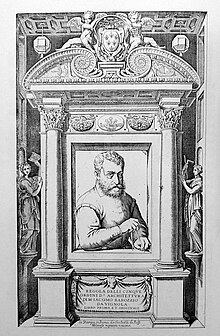
Back ياكوبو باروتسي دا فينيولا Arabic جياكومو باروزى دا فيجنولا ARZ Джакама да Віньёла Byelorussian Jacopo Vignola Catalan Jacopo Barozzi da Vignola Czech Giacomo Barozzi da Vignola German Jacopo Vignola Esperanto Jacopo Vignola Spanish Jacopo Barozzi Basque Giacomo da Vignola Finnish
Giacomo Barozzi da Vignola | |
|---|---|
 | |
| Born | 1 October 1507 |
| Died | 7 July 1573 (aged 65) Rome, Papal States (present-day Italy) |
| Known for |
|
| Notable work | |
| Movement | Mannerism |

Giacomo[a] Barozzi[b] da Vignola (UK: /vɪnˈjoʊlə/ vin-YOH-lə,[1] US: /viːnˈ-/ veen-,[2] Italian: [ˈdʒaːkomo baˈrɔttsi da (v)viɲˈɲɔːla]; 1 October 1507 – 7 July 1573), often simply called Vignola, was one of the great Italian architects of 16th century Mannerism. His two great masterpieces are the Villa Farnese at Caprarola and the Jesuits' Church of the Gesù in Rome. The three architects who spread the Italian Renaissance style throughout Western Europe are Vignola, Serlio and Palladio. He is often considered the most important architect in Rome in the Mannerist era.[3]
Cite error: There are <ref group=lower-alpha> tags or {{efn}} templates on this page, but the references will not show without a {{reflist|group=lower-alpha}} template or {{notelist}} template (see the help page).
- ^ "Vignola, Jacopo Barozzi da". Lexico UK English Dictionary. Oxford University Press.[dead link]
- ^ "Vignola". Merriam-Webster.com Dictionary. Retrieved 28 July 2019.
- ^ De Agostini 2011, p. 200.
© MMXXIII Rich X Search. We shall prevail. All rights reserved. Rich X Search